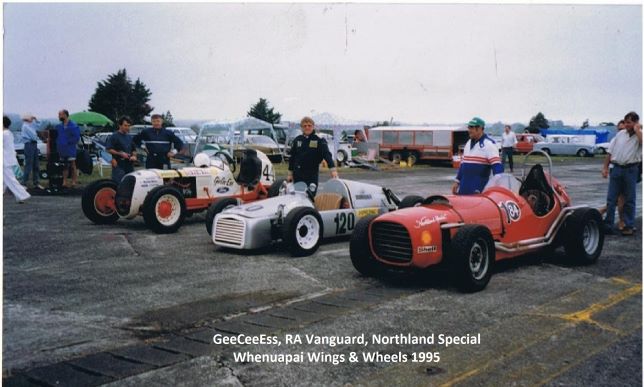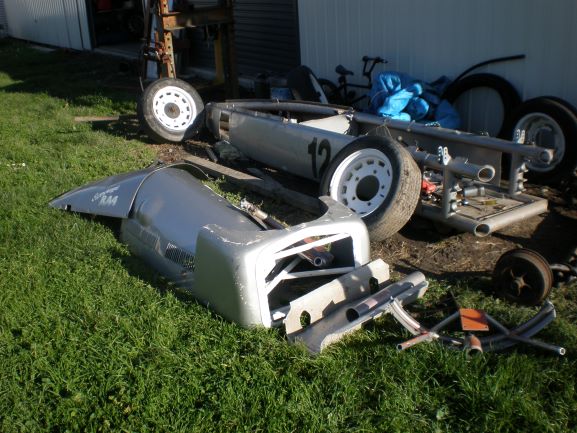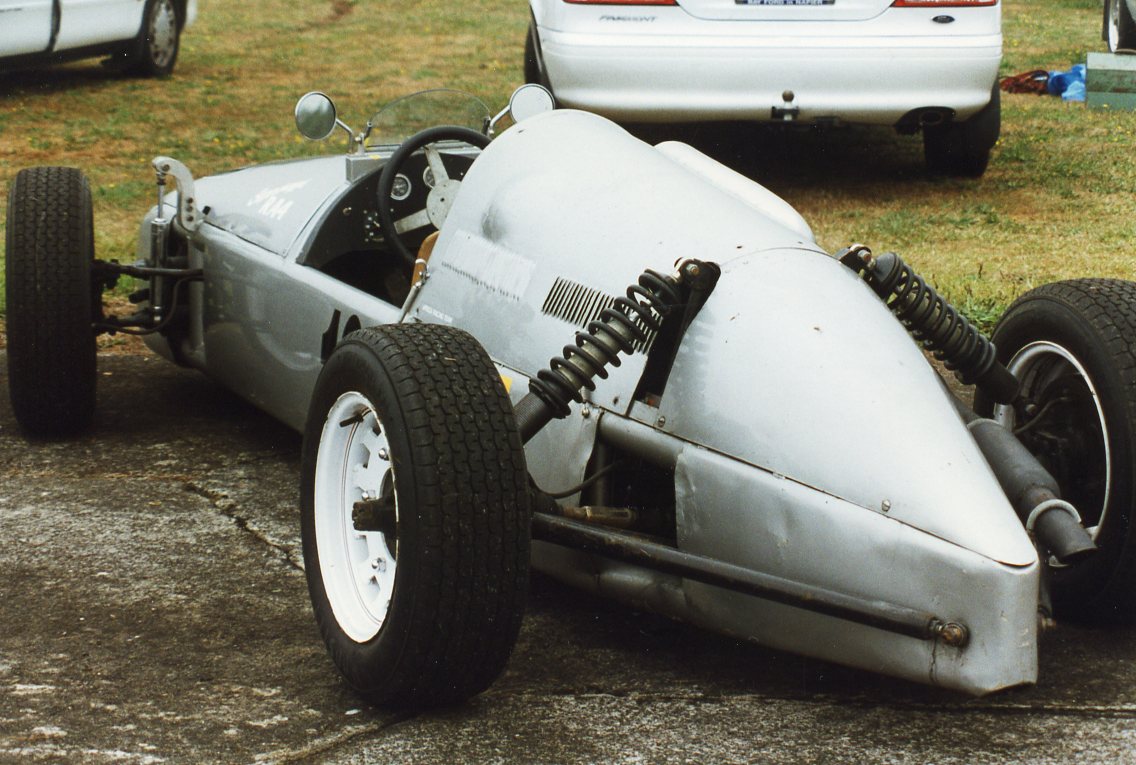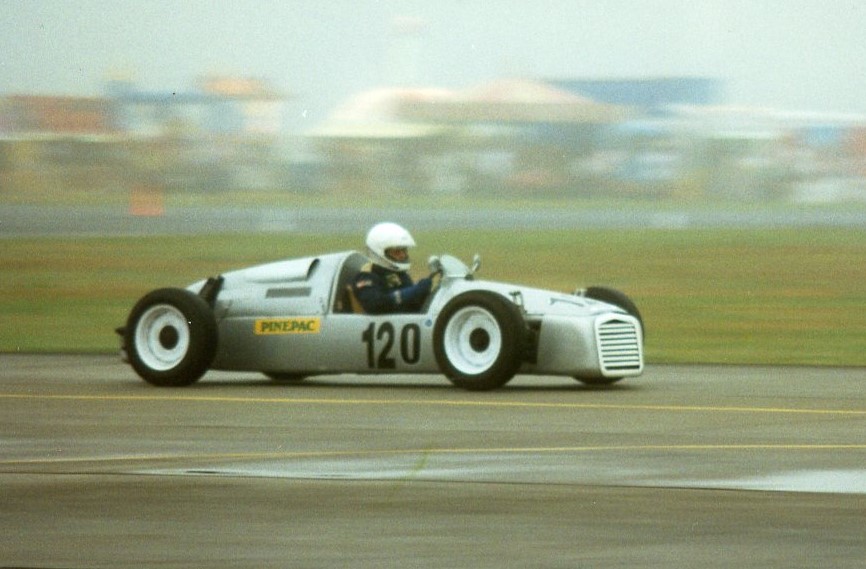Just how much of a Vanguard motor interchanged with the Fergy?
The block didn't, for a start.
As for the previous photo, described as involving Scott-Brown, McLaren, Jenson and Mardon, I'd like to see that.
Just how much of a Vanguard motor interchanged with the Fergy?
The block didn't, for a start.
As for the previous photo, described as involving Scott-Brown, McLaren, Jenson and Mardon, I'd like to see that.
Ray,
Now you have me completely confused !
"Standard wet liner inline-four engine - Wikipedia
https://en.wikipedia.org/wiki/Standa...ne-four_engine
The Standard wet liner inline-four engine was a 2,088 cc inline four cylinder petrol engine produced by the Standard Motor Company. Originally developed for the Ferguson TE20 tractor, it was widely used for Standard passenger cars of the 1950s, most notably the Vanguard.
Cylinder bore: 80 mm (later 85 mm) Head material: cast iron
Piston stroke: 92 mm Block material: cast iron, wet liners. "
https://en.wikipedia.org/wiki/Standard_Vanguard
Ken H
1958 Dunedin Road Race field. Feb. 1 1958.
(Sergent.com.au info )
p.s. Who was Dick Gibson ?
(Ken H)
A week earlier they had raced at Wigram Airfield. January 25 1958
The RA Vanguard can barely be seen as the nose just shows at the far right in this photo of the start of the race.
SO sad that some of these drivers did not live to come back to NZ again. 1958 was a terrible year in motorsports for fatalities and the following 1959 NZGP almost had Mike Hawthorn compete but plans changed and he died speeding down an English road a week after Ardmore ! (If only !)
(Ken H)
Last edited by khyndart in CA; 04-25-2019 at 07:51 PM.
The Vanguard was first 1800cc and then 2-litres.
Different liners and pistons (to get 2088cc) were used in the Ferguson block, which was a deeper casting to enable it to perform chassis duties. The camshaft would have been different, the distributor would have had a different advance curve, it certainly had a different rotor button (with rev limiter). The head was probably the same, the flywheel would have differed.
I recall people telling me they'd used Ferguson liners and pistons to increase the capacity of their Vanguards. Later the TRs used bigger liners and pistons too.
RA Vanguard - more information ;
The name RA came from " Racing Automobiles "
Have just dug out the " New Zealand Classic Car - Limited Edition Collector' Series Volume #5 " published around 2005 - there is a Huge article on Hec Green [ Jack Brewer the other half of RA Engineering ] and the RA Cars - Pages 18 to 49, the article by Penn McKay who wrote for NZCC for many years.
There is on TRS the thread #1038 [ an early one from 2013] which as a lot of information on the car ;
RA4 or RA Vanguard as it is better known.
Perhaps Steve could merge to two threads #1038 and this one #2521.
Stu Buchanan David McKinney and others write on the earlier thread
Go to ;
" http://www.theroaringseason.com/show...83-RA-Vanguard "
The Cars were - according to Penn McKay;
RA1 - the Wolseley Special,later became the ACE1 and ACE2
RA2 Singer Special built for Pat Hore - known as RA Vauxhall and RA Zephyr, later the 260M Zephyr of Ron Rutherford
RA3 Fiat 1100 built for Des Wild, later Chevrolet, Vauxhall and finally Lycoming powered with Duncan Rutherford.
RA4 " RA Vanguard " - passed through many hands including Les Moore [ fatally] Grant Cowie [ who collected most of the bits ] , John Holdsworth, Mike Courtney, to finally Richard Anderson. [ the order of ownership of Mike and John I am unsure now clarified by Richard and corrected here John before Mike and put it together !! .
Hope this is of some interest Guys !!
Last edited by Roger Dowding; 04-27-2019 at 04:56 AM. Reason: more info #### 47
An excellent article in classic and sports car up until Grant Cowie is mentioned then it goes totally off the rails. The car was not built by Mike Courtenay, I built the car. Totally, everything from the research, the chassis frame, body work and engineering. The only thing that I outsourced was the sewing of the leather upholstery.
So to put the record STRAIGHT once and for al,l Mike Courtenay did own the car but had absolutely no input into its build. The remains recovered by Grant Cowie were offered for sale in Beaded Wheels for an extended period before being purchased by John Holdsworth. John had a local Auckland panel shop make up a new body /frame etc to incorporate what remained mechanically of the original car, and while this did serve to keep all of the remaining components in one place, it bore only a passing resemblance to the Green / Brewer device.
That reincarnation was purchased by Mike Courtenay (the car that is in Roger Dowding photographs) who did very little racing with it, His brother John raced it at Hamilton and had rear suspension failure (either before or after mounting the kerb) That damage was repaired and Mike put the car on the market, with little interest resulting. Having recently sold my Cooper I was interested in another car so I arranged for Mike to bring it down to a test day (whenuapai) I had a play with it, and with the assistance of Ralph Watson we got it going reasonably well, enough anyway to show its promise and I purchased it from Mike along with the trailer.
I raced it in HRSCC and VCC events for a number of years until (another) blown head gasket side lined it. Upon stripping it down I decided that it was time to undertake a total rebuild to bring it back to what the original Hec Green / Jack Brewer device had been.
As it was, the car was incorrectly built totally out of aluminium (not steel as originally) including the chassis frame, it was too long by 17 inches, it was too wide, it was too low, it had VW front suspension, it had modern coil over rear shocks, it had swing axles - not low pivot, VW hubs and brakes and "steelie" 15 inch wide wheels. single carburetor, a hot long overlap cam not suitable for supercharging, ALL OF WHICH WERE INCORRECT. I scrapped all of the aluminum (and got paid the princely sum $70 by the scrap metal man). (see accompanying photos)
I took extensive advice from Jack Brewer ( Hec by this time was in Aus and had other interests) I had to try to think like a couple of ex RNZAF WW2 engineers with no money who wanted to go racing and apply that mindset to the rebuild. I fabricated a new chassis exactly as described by Jack Brewer, built the trailing link front end and front uprights exactly as they had been originally, obtained 'bungy cords" of suitable dimension from an aircraft parts supply company in USA, I even managed to locate after much searching and at considerable cost the correct Kittyhawk suspension struts. The car was rebuilt exactly as it was in its time with Les Moore (who changed the wheels from the original troublesome welded ones to wires) I changed the carburation to the same progressive arrangement that had been used by Hec with a 1 1/2 downdraft carb providing initial fuel with a 2 inch side draft coming on from about 1/3 throttle. (the original sandcast 2 inch was outside my budget so the HD8 was fitted) had a new more appropriate cam ground, I made up a dashboard comprising aircraft instruments (as could have been purchased post war from surplus sales.)
I raced the finished article for a number of years during which time I had numerous mechanical issues mostly associated with it blowing head gaskets, cracking or and melting pistons (remember that we are talking of a supercharged engine running with up to 16 lb boost) so detonation was the probable culprit. When it was going well it was at the front of the pack but unfortunately after most race meetings I was faced with an engine strip down, and another engine rebuild.
The Hec Green built gearbox provided for a very high drive ratio 6:1 in 1st, 4.5:1 in second and 3:1 in top. As a consequence racing at Taupo club circuit was all 1st and second gear, even on the full Taupo circuit it only got into top briefly near the end of the back straight.
I ran it on methanol, on a methanol blend, on various fuel ratios, but didnt start to get reliability until I lowered the compression ratio and changed out the fixed spark magneto for a distributor which provided advance and retard. These changes provided no decrease in performance but made the car much more driveable and reliable.
It was in this form that I offered the car for sale, it being purchased by Rob Whitehouse and Paul Radisich. I sincerely hope that they do get to run it at Goodwood, I will be over there again this year and would take great delight in seeing it stretch its legs
these photos show the car as it was purchased from Mike Courtenay, and the aluminum chassis in the final stages of cutting up for scrap


Last edited by Nodiff; 04-26-2019 at 09:36 PM. Reason: spelling captions
Yes, but not with rubber bands!
" I recall people telling me they'd used Ferguson liners and pistons to increase the capacity of their Vanguards. Later the TRs used bigger liners and pistons too. "
When is the USA in 1982 there was a liner kit available to sleeve the engine to capacity of 2498 from the 2138 of the TR4 and 4A's
I was tempted to get one..
Nodiff, Thanks for the information.
I saw the car at Mikes and it was assembled, I am now annoyed I only took photos of the motor.
Will be interested in the C and S C article when the mag comes out - I would assume as a contributor Steve Holmes got an Airmailed ' advance ' copy.
Cheers Guys,
Roger the link to the online version of the article is attached
Richard
https://drive-my.com/en/test-drive/i...ponent&print=1
Great for the true story of RA 4 to make this thread. Is there someone out there with where RA 5 is at this part of it's journey?
RA5 is with Errol Norris in Christchurch, It is complete and He has owned it for many years and I understand is making some progress to getting it back together
Thanks Richard [ Nodiff ] .. will have a good read.
Meanwhile I am editing a story on Jim Bennett and his Furi Cars which will be on TRS my Dunedin thread in the coming days [ weeks depending how long it takes ]. Jim wanted the story told correctly and kindly gave it to me " in his own words " and family archive pictures of his an other cars.
I've just found this photo I took at Pukekohe. I can't remember the date but I seem to recall it had a For Sale sign on it and the price being $10,000.

A foggy day at Whenuapai in 1997.

Hello everyone . Just over two years ago I purchased the Ra4 vanguard. I bought the car as I fly a 1940 warbird and loved the fact the car was made up of Ww2 fighter parts. Back in dec 22 I have instigated a complete restoration and recommissioning of the car in keeping with Richards original view to be true to the original design. This is involving a complete engine rebuild with the aim to ensure reliability for racing. (A lot of the budget going on this element!The chassis has been shot blasted and all cracks addressed and now ready for painting. The gear box is a one off and is being rebuilt. (Some major wear on the crown wheel and pinion so we will have to machine a duplicate replacement.) Suspension bungies need replacing like for like . The aim is to have the car completed in early summer where I intend to launch and photo shoot it a Duxford airfield with the fighter collection as they have some p40 kittiehawkes . I am also hoping I can get it racing at Goodwood this year.